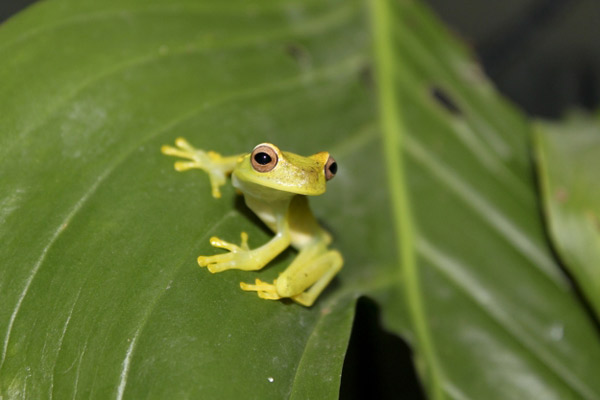Endangered Tree Frog Bred In Captivity for the First Time


Frog populations around the world have been falling victim to a deadly infection, but there may be a ray of hope for their future: For the first time Panama's La Loma tree frog has been bred in captivity.
The critically endangered La Loma tree frog (Hyloscirtus colymba) is notoriously difficult to care for in captivity, but scientists with the Panama Amphibian Rescue and Conservation Project have successfully bred the species in their facility.
The rescue project has 28 adult La Loma tree frogs and the four tadpoles that have resulted from the program at the Summit Municipal Park outside of Panama City, Panama. Researchers have also successfully bred the endangered Limosa harlequin frog (Atelopus limosus).
"We are some of the first researchers to attempt to breed these animals [in] captivity, and we have very little information about how to care for them," said Brian Gratwicke, a research biologist at the Smithsonian National Zoo. "We were warned that we might not be able to keep these frogs alive, but through a little bit of guesswork, attention to detail and collaboration with other husbandry experts, we've managed to breed them."
Currently, almost one-third of the world's amphibian species are at risk of extinction. The amphibian rescue project aims to save more than 20 species of frogs in Panama, which is one of the world's last strongholds for amphibian biodiversity.
The project's efforts and expertise are focused on establishing captive populations that maintain enough of each species to repopulate in the wild if the need arises and developing ways to reduce the impact of the amphibian chytrid fungus so that one day captive amphibians may be reintroduced to the wild.
While the global amphibian crisis is partly the result of habitat loss, climate change and pollution, the fungus called chytridiomycosis is likely also responsible for the disappearances of 94 of the 120 frog species thought to have gone extinct since 1980.
Get the world’s most fascinating discoveries delivered straight to your inbox.
"Although the outlook for amphibians is grim, the rescue project's recent developments give us hope for these unique Panamanian species," said Roberto Ibáñez of the Smithsonian Tropical Research Institute. "We are creating what amounts to an ark for these animals so that their species may survive this deadly disease. We're also looking for a cure so that someday we can safely release the frogs back into the wild."
Of Panama's six harlequin frog species, five are in collections at the Summit Zoological Park and the El Valle Amphibian Conservation Center in El Valle, Panama. One of these species, the Chiriqui harlequin frog (A. chiriquiensis) from western Panama, is likely extinct. The other species range from being endangered to being extinct in the wild.
- Mug Shots: 10 Lost Amphibians
- Three Species of "Extinct" Frogs Rediscovered
- 10 Species You Can Kiss Goodbye
This article was provided by OurAmazingPlanet, a sister site of LiveScience.



